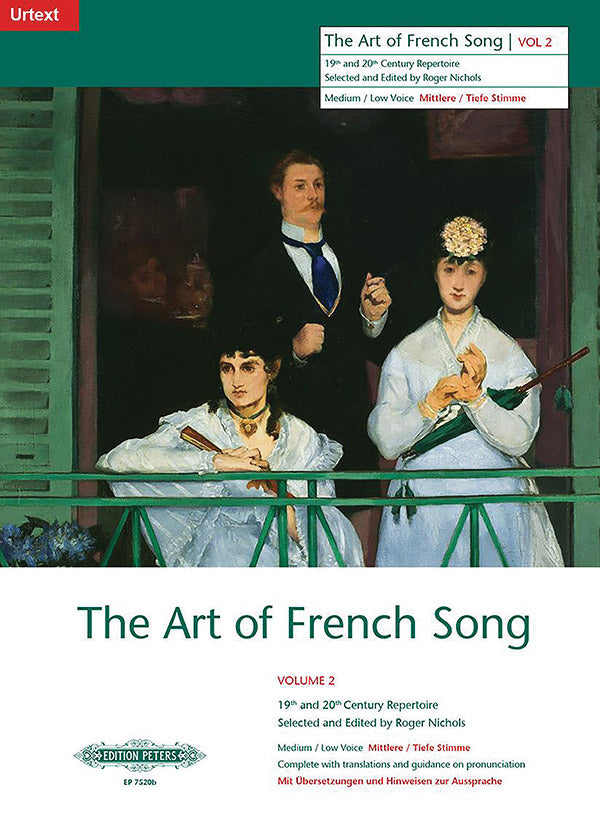The Art of French Song - Volume 2
- Work Language: French
- ISMN:
- Size: 8.8 x 12.0 inches
- Pages: 116
- Urtext / Critical Edition
Description
Those interested in French music have often had reason to be grateful to Roger Nichols; his writings on Debussy, Ravel, Messiaen and Poulenc are indispensable to themusic lover. Nichols now turns his attentionsto the mélodie, where it is his mission to encourage singers to explore beyond the well-trodden paths of French song. in these two anthologies he does not ignore masterpieces by composers of the stature of Fauré and Duparc, but sets them alongside music – almost impossible to find elsewhere in print – by such under-estimated figures asReber, Viardot, Massé and Paladilhe. Even themore celebrated songs are often not easily found in practical editions, which makes thisselection an ideal starting point for wider exploration. in each of these volumes the songs appear in the chronological order of their composer's birth, but Nichols somehow contrives a line-up of music which seems delightfully arbitrary at the same time as carefully designed to enrich everyone's understanding of the mélodie. The books also contain a remarkable amount of scholarship, lightly worn and pithily expressed. As well as complete translations of the songs, there is a useful and concise introduction on singing in French, together with an illuminating historical note and critical commentary; and Nichols gives full due to thepoets who were of crucial importance in the development of the mélodie tradition. Graham Johnson
- Reber: Guitare
- Gounod: Le soir
- Gounod: Le premier jour de mai
- Viardot: Les deux roses
- Viardot: La mésange
- Franck: Nocturne
- Massé:Souvenirs
- Lalo: Chant breton
- Saint-Saëns: Chanson triste
- Bizet: Vieille chanson
- Massenet: Madrigal
- Massenet: Ouvre tes yeux bleus
- Chabrier: Les cigales
- Paladilhe: Sonnet de Pétrarque
- Fauré: Automne
- Fauré: Le secret
- Duparc: La vie antérieure
- Chausson: Nocturne
- Debussy: Le jet d'eau
- Satie: Sylvie
- Séverac: Philis
- Honegger: Automne
- Poulenc: Fleurs
Publishers use a lot of words to describe what they sell, and we know it can be confusing. We've tried to be as clear as possible to make sure you get exactly what you are looking for. Below are descriptions of the terms that we use to describe the various formats that music often comes in.
Choral Score
A score for vocalists that only contains the vocal lines. The instrumental parts are not there for reference. Generally, cheaper than a vocal score and requires multiple copies for purchase.
Facsimile
Reproductions of the original hand-written scores from the composer.
Full Score
For ensemble music, this indicates that the edition contains all parts on a single system (there are not separate parts for each player). In larger ensembles, this is for the conductor.
Hardcover
Hardbound. Generally either linen-covered or half-leather.
Orchestral Parts
Similar to a wind set, this is a collection of parts. In the case of strings, the numbers listed are the number of copies included, though generally these are available individually (often with minimum quantities required).
Paperback
When publishers offer multiple bindings (e.g. hardcover) or study scores, this is the "standard" version. If you're planning to play the music, this is probably what you want.
Performance / Playing Score
A score of the music containing all parts on one system, intended for players to share. There are not separate parts for each player.
Set of Parts
For ensemble music, this indicates that there are separate individual parts for each player.
Solo Part with Piano Reduction
For solo pieces with orchestra, this is a version that contains a piano reduction of the orchestra parts. For piano pieces, two copies are typically needed for performance.
Study Score
A small (think choral size) copy of the complete score meant for studying, and not playing. They make great add-ons when learning concertos and small chamber works.
Vocal Score
A score prepared for vocalists that includes the piano/organ part or a reduction of the instrumental parts.
Wind Set
For orchestral music, this is a collection of wind and percussion parts. The specific quantities of each instrument are notated.
With Audio
In addition to the printed music, the edition contains recordings of the pieces. This may be an included CD, or access to files on the internet.
With / Without Fingering (Markings)
Some publishers prepare two copies - a pure Urtext edition that includes no fingering (or bowing) suggestions and a lightly edited version that includes a minimal number of editorial markings.






